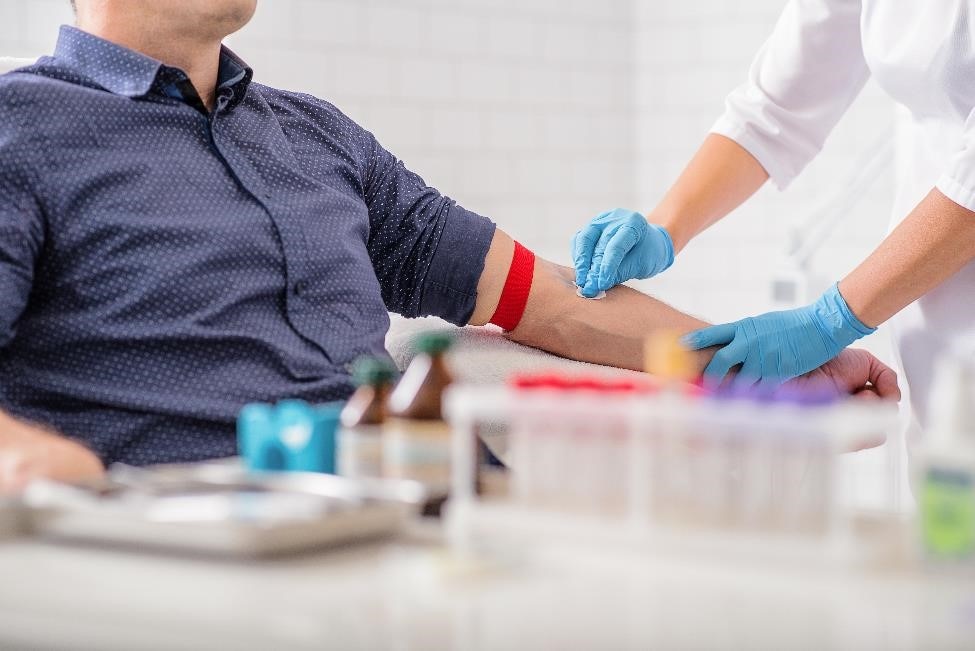Hemochromatosis
Return to Overview PageDefinition & Facts
In this section:
- What is hemochromatosis?
- Are there different types of hemochromatosis?
- How common is hemochromatosis?
- Who is more likely to have hemochromatosis?
- What are the complications of hemochromatosis?
What is hemochromatosis?
Hemochromatosis is a disorder in which extra iron builds up in the body to harmful levels.
Your body needs iron to stay healthy, make red blood cells, build muscle and heart cells, and do the daily tasks that your body and internal organs need to do. However, too much iron is harmful.
The human body typically controls the amount of iron that is absorbed from the diet, increasing the amount when iron is needed and decreasing the amount when iron levels in the body are too high. In hemochromatosis, the body absorbs too much iron from the diet each day.
Without treatment, hemochromatosis can cause iron overload, a buildup of iron that can damage many parts of the body, including the liver, heart, pancreas, endocrine glands, and joints.
Are there different types of hemochromatosis?
Primary hemochromatosis, also called hereditary or inherited hemochromatosis, is caused by inherited mutations in genes that control how much iron is absorbed from the diet.
Secondary hemochromatosis, also called secondary iron overload or hemosiderosis, is caused by too much iron in the diet or too much iron from blood transfusions, such as transfusions that treat severe anemia.
Neonatal hemochromatosis is a very rare condition caused by injury to the liver of a fetus in the womb. This liver injury causes extra iron to build up in the liver and other organs.
How common is hemochromatosis?
The most common forms of hemochromatosis are due to mutations in a gene called HFE. The HFE mutation that most commonly causes hemochromatosis is called C282Y. Another HFE mutation that may lead to iron overload is called H63D. People with two copies of C282Y are most likely to have iron overload. People with one copy of H63D and one copy of C282Y may also have iron overload, but this is less common and usually less severe.
About 1 in 15 people of Northern European ancestry have at least one copy of the C282Y mutation in the HFE gene.1 This means that about 1 in 225 people in this population have two copies of the gene and are at risk of developing hemochromatosis.2 Primary hemochromatosis is much less common in people of Asian or African ancestry because the C282Y gene mutation is far less common in these populations.
Who is more likely to have hemochromatosis?
Caucasians are more likely than other groups to have hemochromatosis because the C282Y gene mutation is most common in this population.
Men and women are just as likely to have C282Y mutations, but men are more likely to develop iron overload and the symptoms and complications of hemochromatosis. In people with these mutations, it can take many decades for iron to build up to harmful levels. Symptoms do not typically develop before age 40.3 On average, women develop symptoms about 10 years later than men do, usually after menopause.4 The differences between men and women are due to menstruation, which leads to blood loss and reduces iron levels in women.
Among people with the C282Y mutations, lifestyle factors and health problems can also increase the risk of severe iron overload and symptoms and complications of hemochromatosis. These include
- other chronic liver diseases, particularly chronic hepatitis C
- heavy alcohol drinking, which the National Institute on Alcohol Abuse and Alcoholism defines as more than 14 drinks per week for men and more than 7 drinks per week for women
What are the complications of hemochromatosis?
Without treatment, hemochromatosis may lead to iron overload and complications in your liver and other parts of your body.
Cirrhosis
In cirrhosis, scar tissue replaces healthy liver tissue and prevents your liver from working normally. Scar tissue also partly blocks the flow of blood through the liver. As cirrhosis gets worse, the liver begins to fail.
Liver failure
Cirrhosis may eventually lead to liver failure, also called end-stage liver disease. With liver failure, your liver is badly damaged and stops working. People with liver failure may require a liver transplant.
Liver cancer
Cirrhosis increases your chance of getting liver cancer. Your doctor may suggest blood tests and an ultrasound or another type of imaging test to check for liver cancer. Finding cancer at an early stage improves the chance of curing the cancer.
Other complications
In addition to harming the liver, iron overload can damage other parts of the body, including the joints, pancreas, heart, and sex glands. This damage can lead to
- arthritis
- diabetes
- heart failure
- loss of interest in sex and erectile dysfunction, because iron damage lowers sex hormone levels

References
Symptoms & Causes
What are the symptoms of hemochromatosis?
With the buildup of harmful levels of iron, hemochromatosis can cause symptoms including
- feeling tired or weak
- pain in the joints, particularly in the knees and hands
- loss of interest in sex or erectile dysfunction
- pain in the abdomen over the liver
- darkening of skin color, which may appear gray, metallic, or bronze
With more severe iron overload, people may develop signs and symptoms of complications, such as cirrhosis, diabetes, or heart failure.
Not everyone with hemochromatosis has symptoms, and hemochromatosis may not cause symptoms for many years. Symptoms typically begin after age 40, and, on average, women develop symptoms about 10 years later than men do.5,6

What causes hemochromatosis?
Primary hemochromatosis
Mutations in genes that control how the body absorbs iron cause primary hemochromatosis. The most common mutations are in the HFE genes and are called C282Y and H63D.
The important HFE mutations are autosomal recessive, meaning that a person must inherit two copies of the HFE gene with the mutation to have hemochromatosis. The most common pattern in primary hemochromatosis occurs with two copies of C282Y. Two copies of C282Y are present in about 85 to 90 percent of cases of primary hemochromatosis.6 A less common pattern that leads to milder iron overload is caused by having one copy of C282Y and one of H63D.
Mutations in other genes that control how the body manages iron levels cause 10 to 15 percent of cases of primary hemochromatosis.3 These rare forms are called non-HFE hemochromatosis. The most severe forms of non-HFE hemochromatosis are due to mutations in the HJV genes or the HAMP genes. People with these mutations develop symptoms and complications at a young age and may have cirrhosis and other complications from iron overload by their teenage years.
Secondary hemochromatosis
Secondary hemochromatosis is caused by excessive iron in the diet or from multiple blood transfusions.
The usual cause of secondary hemochromatosis is blood transfusions given for severe types of anemia, such as sickle cell disease or thalassemias. In addition, people with bone marrow failure and severe anemia may require regular blood transfusions given over months or years. Red blood cells are a rich source of iron, and red blood cells given by transfusions can lead to a buildup of iron to high levels. The body does not have a good way to get rid of iron.
In the past, iron overload was a common problem in people with kidney failure. However, the use of erythropoietin (EPO) to treat anemia in chronic kidney disease in people with kidney failure has lessened the chance of iron overload. EPO helps the body make red blood cells, lowering levels of stored iron and reducing the need for blood transfusions.
Iron overload in the liver also occurs in persons with severe liver disease such as cirrhosis due to alcoholic liver disease or advanced forms of chronic hepatitis B or C. In these situations, the level of iron is high enough to worsen the underlying liver disease.
Iron overload from excess iron in the diet is very rare but can be caused by cooking and brewing alcohol in crude iron pots or skillets. Drinking alcohol in this situation leads to an increase in the absorption of iron and can cause serious iron overload in the liver.
Neonatal hemochromatosis
Neonatal hemochromatosis is a very rare disease that leads to cirrhosis and liver failure in newborns. In most cases, neonatal hemochromatosis occurs when a pregnant woman’s immune system produces antibodies that damage the liver of a fetus, causing iron overload.
A woman who has one child with neonatal hemochromatosis is at risk for having a second or third affected newborn. Doctors can treat women during future pregnancies to help prevent neonatal hemochromatosis.
References
Diagnosis
How do doctors diagnose hemochromatosis?
Doctors usually diagnose hemochromatosis based on blood test results. Doctors may first suspect hemochromatosis based on a medical and family history, a physical exam, and blood tests.
Medical and family history
Doctors ask about medical history, including
- symptoms of hemochromatosis, such as feeling tired or weak or pain in the joints
- health problems that may be complications of hemochromatosis, such as diabetes or arthritis
Doctors also ask about any family history of hemochromatosis or health problems such as cirrhosis or diabetes.
Physical exam
During a physical exam, the doctor will check for signs of hemochromatosis, such as
- changes in skin color
- enlargement of the liver or spleen
- tenderness in the abdomen over the liver
- tenderness and swelling in the joints
What tests do doctors use to diagnose hemochromatosis?
Blood tests are critical for the diagnosis of hemochromatosis. In some cases, doctors may also order a liver biopsy.
Blood tests
For a blood test, a health care professional will take a blood sample from you and send the sample to a lab. Doctors may order blood tests to check
- levels of iron
- levels of transferrin, the protein that carries iron in the blood
- the ratio of iron to transferrin
- levels of ferritin, the protein that stores iron in the liver
A high ratio of iron to transferrin in the blood may suggest a person has hemochromatosis. A high ferritin level is also typical in people who have hemochromatosis. Doctors may also use blood tests for ferritin levels to see if iron levels are improving with treatment.
Doctors usually order blood tests to check for the gene mutations that cause hemochromatosis. Finding two copies of the HFE gene with the C282Y mutation confirms the diagnosis of primary hemochromatosis.

Liver biopsy
In some cases, doctors will use a liver biopsy to confirm that iron overload is present and that no other liver diseases are present. The liver biopsy also shows whether iron overload has caused scarring or permanent damage to the liver.
During a liver biopsy, a doctor will take small pieces of tissue from the liver. A pathologist will examine the tissue with a microscope. The biopsy can be stained for iron, which will show whether too much iron appears to be present. The biopsy can also be used to measure the actual amount of iron in the liver.
Treatment
How do doctors treat hemochromatosis?
In most cases, doctors treat hemochromatosis with phlebotomy, or drawing about a pint of blood at a time, on a regular schedule. This is the most direct and safe way to lower body stores of iron.
Treatment of hemochromatosis can improve symptoms and prevent complications.
Phlebotomy
Phlebotomy removes extra iron from your blood. Phlebotomy is simple, inexpensive, and safe.
How much blood is drawn and how often depends on your iron levels. Doctors usually start by having a pint of blood drawn once or twice a week for several months. Doctors will order regular blood tests to check iron and ferritin levels.
Phlebotomy is usually done in blood banks just like routine blood donation. In some cases, blood drawn from people with hemochromatosis may be donated and used in people who need blood transfusions.
After phlebotomy has removed extra iron and blood levels of iron and ferritin return to normal, doctors will reduce phlebotomies to once every 1 to 3 months and eventually to 2 to 3 times a year. Doctors will continue to order regular blood tests to check iron and ferritin levels.
Other treatments
People who receive blood transfusions to treat certain types of anemia and develop secondary hemochromatosis cannot have phlebotomy to lower their iron levels. To treat secondary hemochromatosis in these people, doctors prescribe medicines, called chelating agents, that bind to iron and allow it to pass from the body in urine. Chelating agents may be pills taken by mouth or intravenous (IV) medicines, and they do not remove iron as effectively as phlebotomy.
Doctors treat neonatal hemochromatosis in newborns with exchange transfusions—removing blood and replacing it with donor blood—and IV immunoglobulin—a solution of antibodies from healthy people. These treatments do not always work to reverse severe liver damage, and a liver transplant may be needed. Often the newborn’s mother or father can serve as a living liver donor. Only a small part of the adult donor liver is needed for transplantation into a newborn.
How do doctors treat the complications of hemochromatosis?
Phlebotomy can prevent the complications of hemochromatosis. For people who already have complications such as cirrhosis, liver failure, or liver cancer when they are diagnosed with hemochromatosis, phlebotomy may not be able to restore health.
Doctors can treat many complications of cirrhosis with medicines, minor medical procedures, and surgery. People with liver failure or liver cancer usually need a liver transplant to restore health.
Can I prevent hemochromatosis?
You can’t prevent inheriting the gene mutations that cause primary hemochromatosis. However, early diagnosis is important since early treatment with phlebotomy can prevent complications of iron overload caused by these gene mutations.
If you have a close relative—a parent, brother or sister, or child—with hemochromatosis, you should be checked for hemochromatosis. Talk with your doctor about testing you and your family members.
Secondary hemochromatosis due to blood transfusion cannot be prevented easily. However, doctors can check iron levels and start treatment with chelating agents early, before iron overload causes damage to the liver, joints, and other organs.
If doctors know a pregnant woman is at risk for having an infant with neonatal hemochromatosis due to a family history of the condition, doctors can treat the pregnant woman with IV immunoglobulin to lower the chance that the newborn will have severe iron overload.

Eating, Diet, & Nutrition
What should I eat if I have hemochromatosis?
If you have hemochromatosis, you should eat a healthy, well-balanced diet. Talk with your doctor, a dietitian, or a nutritionist about healthy eating.
What should I avoid eating if I have hemochromatosis?
Your doctor may recommend avoiding
- raw or undercooked shellfish, which can cause a serious infection in people with liver disease
- supplements that contain iron
- supplements that contain vitamin C, which can increase the body’s absorption of iron
Talk with your doctor before using dietary supplements, such as vitamins, or any complementary or alternative medicines, such as herbal or botanical medicines. Dietary and herbal supplements are usually safe, but some may contain high levels of iron or unsafe chemical or herbal products.
If you have hemochromatosis and don’t have cirrhosis, your doctor may recommend limiting the amount of alcohol you drink to help prevent liver damage. If you have cirrhosis, you should stop drinking alcohol completely.
Most people with hemochromatosis do not need to change their diet to eat less iron. Diet changes have a relatively small effect on iron levels, compared to the much larger effect of removing iron during phlebotomy treatment.
Clinical Trials
The NIDDK conducts and supports clinical trials in many diseases and conditions, including liver diseases. The trials look to find new ways to prevent, detect, or treat disease and improve quality of life.
What are clinical trials for hemochromatosis?
Clinical trials—and other types of clinical studies—are part of medical research and involve people like you. When you volunteer to take part in a clinical study, you help doctors and researchers learn more about disease and improve health care for people in the future.
Researchers are conducting clinical studies to better understand liver diseases, such as hemochromatosis.
Find out if clinical studies are right for you.
What clinical studies for hemochromatosis are looking for participants?
You can view a filtered list of clinical studies on hemochromatosis that are federally funded, open, and recruiting at ClinicalTrials.gov. You can expand or narrow the list to include clinical studies from industry, universities, and individuals; however, the NIH does not review these studies and cannot ensure they are safe. Always talk with your health care provider before you participate in a clinical study.
How has NIDDK- and NIH-funded research advanced the understanding of hemochromatosis?
The NIDDK and other components of the NIH, such as the National Heart, Lung, and Blood Institute (NHLBI), support basic research to increase our understanding of hemochromatosis and lay the foundation for future advances in diagnosis and treatment. For example
- NIDDK-funded researchers were among the group of investigators who discovered that mutations of the HFE gene cause hemochromatosis
- NIDDK-funded researchers discovered iron transporters in the small intestine
- the NHLBI-funded Hemochromatosis and Iron Overload Screening Study (HEIRS) examined the prevalence, genetic and environmental causes, and the effect of iron overload and primary hemochromatosis in a group of about 100,000 adults from multiple ethnic backgrounds
This content is provided as a service of the National Institute of Diabetes and Digestive and Kidney Diseases
(NIDDK), part of the National Institutes of Health. NIDDK translates and disseminates research findings to increase knowledge and understanding about health and disease among patients, health professionals, and the public. Content produced by NIDDK is carefully reviewed by NIDDK scientists and other experts.
The NIDDK would like to thank:
Adrian M. Di Bisceglie, M.D., Saint Louis University School of Medicine

